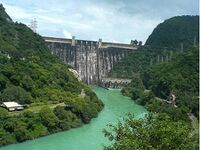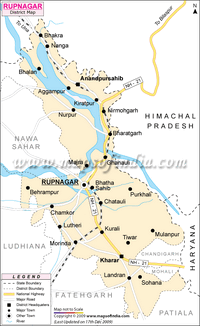Bhakra Dam
| Author:Laxman Burdak, IFS (R) |


Bhakra Dam (भाखड़ा बांध) is a concrete gravity dam on the Sutlej River in Bhakra Village near Bilaspur in Bilaspur district, Himachal Pradesh in northern India. The dam forms the Gobind Sagar reservoir.
Variants
Location
The dam, located at a gorge near the (now submerged) upstream Bhakra village in Bilaspur district of Himachal Pradesh of height 226 m.[1] The length of the dam (measured from the road above it) is 518.25 m and the width is 9.1 m. Its reservoir known as "Gobind Sagar" stores up to 9.34 billion cubic metres of water. The 90 km long reservoir created by the Bhakra Dam is spread over an area of 168.35 km2. In terms of quantity of water, it is the third largest reservoir in India, the first being Indira Sagar dam in Madhya Pradesh with capacity of 12.22 billion cu m and second Nagarjunasagar Dam.
Described as "New Temple of Resurgent India" by Jawaharlal Nehru,[2] the first prime minister of India, the dam attracts tourists from all over India. Bhakra dam is 15 km from Nangal town, Punjab.
Nangal Dam is another dam in Punjab downstream of Bhakra Dam. However, sometimes both the dams together are called Bhakra Nangal Dam though they are two separate dams.
Bhakhra Village
Bhakhra is a Village in Bilaspur Tehsil in Bilaspur District District of Himachal Pradesh State, India. It is located 31 KM towards west from District head quarters Bilaspur, 34 KM from Bilaspur, 85 KM from State capital Shimla. Bhakhra Pin code is 174201 and postal head office is Bhakra Dam . Bakroa ( 4 KM ) , Saloa ( 5 KM ) , Jhabola ( 9 KM ) , Naghiar ( 9 KM ) , Daslehra ( 9 KM ) are the nearby Villages to Bhakhra. Bhakhra is surrounded by Jhandutta Tehsil towards East , Bijhri Tehsil towards North , Una Tehsil towards west , Ghumarwin Tehsil towards East . Nangal , Hamirpur , Sundarnagar , Rupnagar are the near by Cities to Bhakhra. This Place is in the border of the Bilaspur District District and Mandi District. Mandi District Sundarnagar is East towards this place . Also it is in the Border of other district Hamirpur . [3]
History
The Bhakra-Nangal multipurpose dams were among the earliest river valley development schemes undertaken by India after independence though the project had been conceived long before India became a free nation. The agreement for this project had been signed by the then Punjab Revenue Minister, Sir Chhotu Ram in November 1944 with Raja of Bilaspur and finalised the project plan on 8 January 1945. Preliminary works commenced in 1946. Construction of the dam started in 1948; Jawaharlal Nehru poured the first bucket of concrete into the dry riverbed of the Sutlej on 17 November 1955, as a symbolic initiation of the work. Addressing a gathering there, he said, "This is a gift to the people of India and to the future generations from the workers who built this dam", calling for "raising a memorial" at the dam "in honour" of the workers.[4] The dam was completed by the end of 1963. Successive stages were completed by the early 1970s.
Initially, the construction of the dam was started by Sir Louis Dane, the Lieutenant Governor of Punjab. But the project got delayed and was restarted soon after independence under the chief architect Rai Bahadur Kunwar Sen Gupta. It was financed entirely by the union government. The Control Board for the project included representatives from union government, and of the governments of Punjab, Patiala and East Punjab States Union, Rajasthan, Bilaspur and Himachal Pradesh. The organisation evolved for the purpose of design and construction was divided into three parts. The Designs Directorate provided the designs and drawings. The Construction and Plant Design Directorate was to look after its execution and installing of the plant, while the Directorate of Inspection and Control ensured that the specifications are accorded to safety requirements were met.[5]
In October 1963, at the ceremony to mark the dedication of the Bhakra–Nangal project to the nation, Prime Minister Nehru said, "This dam has been built with the unrelenting toil of man for the benefit of mankind and therefore is worthy of worship. May you call it a Temple or a Gurdwara or a Mosque, it inspires our admiration and reverence". On 22 October 2013, the Government of India approved the release of a commemorative stamp to mark the 50th anniversary of the Bhakra Dam. As how successful India was at that time that it was the only dam in Asia which could produce 1500 MW power.
Also, these are multipurpose projects.
Features
The dam, at 741 ft (226 m), is one of the highest gravity dams in the world (compared to USA's largest Oroville Dam at 770 ft). The 166 km2 Gobindsagar Reservoir, named after Guru Gobind Singh, is created by this dam which is the third largest reservoir in India the first being Indira Sagar Dam and second Nagarjunasagar Dam.[5] The river Satluj used to flow through a narrow gorge between two hills, Naina Devi ki dhar and Ramgarh ki dhar, and the site was chosen to dam the river. The large map http://www.lib.utexas.edu/maps/ams/india/nh-43-03.jpg shows the location of the original Bhakra village that was submerged in the lake formed behind the dam.
Bhakra dam was part of the larger multipurpose Bhakra Nangal Project whose aims were to prevent floods in the Satluj-Beas river valley, to provide irrigation to adjoining states and also to provide hydro-electricity. It also became a tourist spot for the tourists during later years because of its huge size and uniqueness.
It also has four spillway gates that are only used when the reservoir exceeds the maximum allowed level.
Nangal dam is a barrage dam that is 10 km downstream of Bhakra dam
Tourism
Being the fourth largest dam in India after Tehri Dam, it attracts a large number of tourists who visit its reservoir and attractive location. However, for security reasons, visitors to Bhakra-Nangal Dam has been banned since Board (BBMB) are also run the Bhakhra Tourism Railway run on narrow gauge railway line just like Darjeeling himalayan railway, from bhakhra dam to nangal dam , there are 8 railway stations, traveling is absolutely free.
भाखड़ा बांध
भाखड़ा बांध: संयुक्त पंजाब के राजस्व मंत्री सर छोटूराम ने भाखड़ा बांध का प्रस्ताव रखा था । सतलुज के पानी का अधिकार बिलासपुर के राजा का था। झज्जर के महान सपूत सर छोटूराम ने संयुक्त पंजाब के राजस्व मंत्री के रूप में बिलासपुर (हिमाचल) के राजा के साथ 1944 में एक समझौते पर हस्ताक्षर किए और योजना को 8 जनवरी 1945 को अंतिम रूप दिया। इस परियोजना का का प्रारम्भिक काम 1946 में शुरू हो गया।
भाखड़ा बांध सतलुज नदी पर बने भाखड़ा-नंगल बांध का ही हिस्सा है। बिलासपुर जिले में स्थित इस बांध का नामकरण भाखड़ा गांव पर किया गया है और यह भारत का दूसरा सबसे बड़ा बांध है। इस बांध पर लगे पनबिजली संयंत्र से पंजाब के अलावा हरियाणा, राजस्थान, गुजरात और हिमाचल प्रदेश में भी विद्युत आपूर्ति की जाती है। साथ ही यह बांध बरसात के दौरान इस क्षेत्र में आने वाले बाढ़ को भी रोकता है। इसके अलावा बांध से सिंचाई व्यवस्था भी दुरुस्त हुई है, जिसका असर कृषि उत्पादन पर देखा जा सकता है। [6]
भाखड़ा-नांगल बांध एक हाइड्रो-इलेक्ट्रिक प्रोजेक्ट है जिसमें बांध के पानी से बिजली बनती है। बांध के जलगृहण-क्षेत्र से पानी के साथ मिट्टी कटकर आती है जिससे बांध में गाद इकट्ठा हो जाती है और बांध की क्षमता को घटा देती है। इस गाद को जमने से रोकने के लिए प्रबंधन द्वारा जो कार्य किए गए हैं उनका अध्ययन किया। केचमेंट एरिया में मिट्टी के कटाव को रोकने के लिए ऐसे वृक्ष और झाड़ियां लगाई गई हैं जो मिट्टी को बांध कर रखती हैं। इसमें मुख्य प्रजातियां हैं- खैर, शिशु, डेडोनियम, आईपोमिया, सेमल, अगेव, वाइटेक्स निगुन्डो, नीम, मुंज आदि।
भाखड़ा नांगल बाँध सतलज नदी पर पंजाब और हिमाचल प्रदेश की सीमा में शिवालिक पहाड़ियों के तल पर स्थित है। बांध की लंबाई 518.25 मीटर और लंबाई चौड़ाई 304.84 मीटर है। यह भारत में सबसे बड़ी बहुउद्देश्यीय परियोजना भी है जिसका निर्माण 1948 में शुरू हुआ और 1968 तक पूरा हो गया। पंजाब, हरियाणा और राजस्थान ने संयुक्त रूप से इस परियोजना को शुरू किया था। भाखड़ा नांगल बाँध को दुनिया का सबसे ऊँचा गुरुत्व बाँध भी कहा जाता है। भाखड़ा नांगल बांध का निर्माण उस समय से शुरू हुआ जब भारत अभी तक एक स्वतंत्र राष्ट्र नहीं था। इस बांध को नए भारत के नए मंदिर के रूप में जाना जाता है और वर्ष 1963 में भारत के प्रथम प्रधान मंत्री जवाहरलाल नेहरू द्वारा राष्ट्र को समर्पित किया गया था। बांध के निर्माण के पीछे मुख्य उद्देश्य पंजाब और हिमाचल के राज्यों को सिंचाई प्रदान करना था। बांध के निर्माण के पीछे एक और प्रमुख कारण मानसून की बाढ़ के कारण होने वाले नुकसान को रोकना था। वर्तमान में बांध लगभग 10 मिलियन एकड़ क्षेत्र में सिंचाई का पानी प्रदान करता है। बांध से सिंचित क्षेत्रों में पंजाब, हरियाणा, हिमाचल प्रदेश, राजस्थान और दिल्ली के खेत शामिल हैं। बांध का एक अन्य महत्वपूर्ण उपयोग हिमाचल प्रदेश, दिल्ली, पंजाब और हरियाणा राज्यों को जल विद्युत प्रदान करना है।
जहां तक पर्यटकों के आकर्षण का सवाल है, भाखड़ा नांगल बांध एक महत्वपूर्ण पर्यटन स्थल है। हिमाचल प्रदेश की हरी-भरी हरियाली के बीच स्थित होने के कारण बड़ी संख्या में पर्यटक साल भर बांध क्षेत्र में आते हैं। प्राकृतिक जलप्रपात गंगवाल और कोटला के बिजलीघरों के माध्यम से जल विद्युत शक्ति उत्पन्न करता है। भाखड़ा बांध की एक महत्वपूर्ण विशेषता इसका विशाल जलाशय है जिसे गोबिंद सागर जलाशय के रूप में जाना जाता है। जलाशय में लगभग 9340 मिलियन घन मीटर पानी स्टोर करने की क्षमता है। गोबिंद सागर दुनिया के सबसे ऊंचे गुरुत्वाकर्षण बांधों में से एक है, जो अपनी सबसे कम नींव से लगभग 225.5 मीटर ऊपर उठता है। अमेरिकी बांध-निर्माता हार्वे स्लोकम ने भाखड़ा बांध के निर्माण की देखरेख की। निर्माण कार्य 1955 के वर्ष में शुरू हो गया था और 1962 में पूरा हो गया था। ब्यास नदी के प्रवाह को पानी के स्तर को बनाए रखने के लिए ब्यास-सतलज लिंक द्वारा गोबिंद सागर से जोड़ा गया था। यह ब्यास गोबिंद सागर चैनल के लिए 1976 में पूरा हुआ था। गोबिंद सागर जलाशय बिलासपुर जिला और ऊना के बीच स्थित है। 1962 में गोबिंद सागर बांध को एक जलपक्षी शरण के रूप में घोषित किया गया था। इस जलाशय में आमतौर पर मछली पकड़ने का कार्य किया जाता है। लगभग 51 प्रजातियाँ और उप प्रजातियाँ हैं। झील के प्रमुख आकर्षण नौका सवारी और पानी के खेल जैसे गति नौका विहार, भीड़ को खींचना है जो झील क्षेत्र को हमेशा व्यस्त रखते हैं।
स्रोत: hindi.gktoday.in/gk-in-hindi/
भारतीय योजनाकारों और अभियन्ताओं द्वारा दो मुख्य महत्वपूर्ण निर्णय लिए गए। पहला निर्णय, भाखडा बांध की अपेक्षा पहले भाखडा नहर प्रणाली निर्मित करने का था तथा दूसरा निर्णय विदेशी विशेषज्ञों की सहायता से विभागीय रूप में बांध का निर्माण करना था। यद्यपि यू.एस.बी आर भाखडा बांध का डिजाइन सलाहकार था फिर भी इसका क्रियावयन सिंचाई विभाग के भारतीय अभियन्ताओं के हाथ में आया। अप्रैल, 1952 के पश्चात जब मि. एम. हारवे स्लोकम अमेरिका से निर्माण तकनीशियनों तथा अभियन्ताओं की अपनी टीम के साथ आए तो इसका पूर्ण रूप से सक्रिय निर्माण कार्य प्राम्भ हुआ।
Notable persons
External Links
References
- ↑ projects.html "Central Water Commission website".
- ↑ http://bbmb.gov.in/english/history_nangal_dam.asp
- ↑ https://www.onefivenine.com/india/villages/Bilaspur-District/Bilaspur/Bhakhra
- ↑ "Nehru Opens Work On Bhakra Dam". The Indian Express. 18 November 1955. p. 1
- ↑ "Bhakra Dam Will Be Engineering Marvel". The Indian Express. 4 September 1955. p. 13.
- ↑ https://hindi.nativeplanet.com/travel-guide/rupnagar-a-beautiful-district-of-punjab-000398.html

